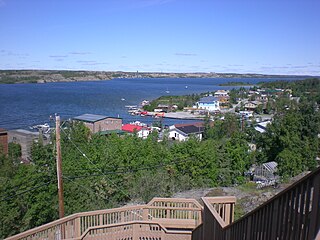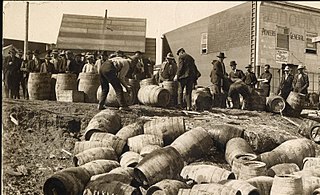Related Research Articles

The Northwest Territories is a federal territory of Canada. At a land area of approximately 1,144,000 km2 (442,000 sq mi) and a 2016 census population of 41,790, it is the second-largest and the most populous of the three territories in Northern Canada. Its estimated population as of 2021 is 45,515. Yellowknife is the capital, most populous community, and only city in the territory; its population was 19,569 as of the 2016 census. It became the territorial capital in 1967, following recommendations by the Carrothers Commission.

Yellowknife is the capital, largest community, and only city in the Northwest Territories, Canada. It is on the northern shore of Great Slave Lake, about 400 km (250 mi) south of the Arctic Circle, on the west side of Yellowknife Bay near the outlet of the Yellowknife River.

Devolution is the statutory delegation of powers from the central government of a sovereign state to govern at a subnational level, such as a regional or local level. It is a form of administrative decentralization. Devolved territories have the power to make legislation relevant to the area, thus granting them a higher level of autonomy.

The Northwest Territories Legislative Assembly, or Legislative Council of the Northwest Territories, is the legislature and the seat of government of Northwest Territories in Canada. It is a unicameral elected body that creates and amends law in the Northwest Territories. Permanently located in Yellowknife since 1993, the assembly was founded in 1870 and became active in 1872 with the first appointments from the Government of Canada.
John Havelock Parker, OC was the commissioner of the Northwest Territories from April 15, 1979 to July 31, 1989. He had previously been Deputy Commissioner of Northwest Territories from 1967 to 1979.
(Robert) Gordon Robertson, was the commissioner of the Northwest Territories from November 15, 1953 to July 12, 1963 who, having been sworn in at the age of 36, remains the youngest person to ever hold the office. He went on to become Clerk of the Privy Council and Secretary to the Cabinet, the top position in the Canadian public service.

The history of Northwest Territories capital cities begins with the purchase of the Territories by Canada from the Hudson's Bay Company in 1869, and includes a varied and often difficult evolution. Northwest Territories is unique amongst the other provinces and territories of Canada in that it has had seven capital cities in its history. The territory has changed the seat of government for numerous reasons, including civil conflict, development of infrastructure, and a history of significant revisions to its territorial boundaries.

Kam Lake is a territorial electoral district for the Legislative Assembly of the Northwest Territories, Canada.
The 1967 Northwest Territories general election took place on July 4, 1967.
Elections NWT is an independent, non-partisan public agency responsible for the administration of territorial general elections, by-elections, and plebiscites in accordance with the Elections and Plebiscites Act. Elections NWT is headed by the Chief Electoral Officer, an officer of the Legislative Assembly of the Northwest Territories.

Norman Wells is a town located in the Sahtu Region, Northwest Territories (NWT), Canada. The town, which hosts the Sahtu Regional office, is situated on the north side of the Mackenzie River and provides a view down the valley of the Franklin and Richardson mountains.
Lena Pedersen or Lena Pederson is a politician and social worker from Nunavut, Canada. In 1959, she moved from Greenland to the Northwest Territories and lived in Coppermine (Kugluktuk), Pangnirtung and Rae (Behchoko) before moving to Cape Dorset where she participated in the artwork sales of the West Baffin Eskimo Co-operative.
The 1st Northwest Territories Legislative Council was the 8th assembly of the territorial government, lasting from the election on September 17, 1951 to dissolution in 1954. This council would see elected members returned it for the first time since 1905.
The 5th Northwest Territories Legislative Council was the 12th assembly of the territorial government. This council's members were elected and appointed in the 1964 general election and served until it was dissolved for the 1967 general election.

Nunavut is the largest and northernmost territory of Canada. It was separated officially from the Northwest Territories on April 1, 1999, via the Nunavut Act and the Nunavut Land Claims Agreement Act, which provided this territory to the Inuit for independent government. The boundaries had been drawn in 1993. The creation of Nunavut resulted in the first major change to Canada's political map in half a century since the province of Newfoundland was admitted in 1949.

Prohibition in Canada was a ban on alcoholic beverages that arose in various stages, from local municipal bans in the late 19th century, to provincial bans in the early 20th century, and national prohibition from 1918 to 1920. The relatively large and powerful beer and alcohol manufacturing sector, and the huge working class that purchased their products, failed to convince any of the governments to reverse their stance on prohibition. Most provinces repealed their bans in the 1920s, though alcohol was illegal in Prince Edward Island from 1901 to 1948. By comparison, Ontario's temperance act was in effect from 1916 to 1927.
This timeline of Yellowknife history summarises key events in the history of Yellowknife, a city in the Northwest Territories, Canada.
Frank Cunningham was a Canadian lawyer and public servant.

The following outline is provided as an overview of and topical guide to the Northwest Territories:

Simonie Michael was a Canadian politician from the Eastern Northwest Territories who became the first elected Inuit legislator in Canada. Before becoming involved in politics, Michael worked as a carpenter and business owner, as well as one of very few translators between Inuktitut and English. He became a prominent member of the Inuit co-operative housing movement and a community activist in Iqaluit, and was appointed to a series of governing bodies, including the precursor to the Iqaluit City Council.
References
- 1 2 "Red Radio Peril Noted In North". Vol 62 No. 95. Winnipeg Free Press. January 18, 1955. p. 7.
- 1 2 3 4 Robertson, Gordon (2000). Memoirs of a very civil servant: Mackenzie King to Pierre Trudeau . University of Toronto Press. pp. 148–149. ISBN 0-8020-4445-X.